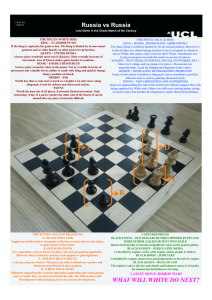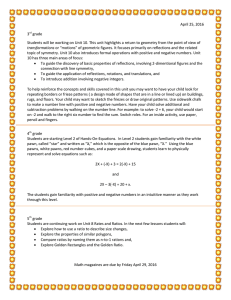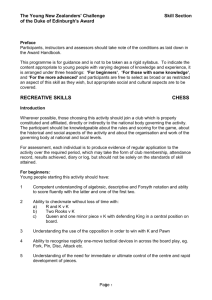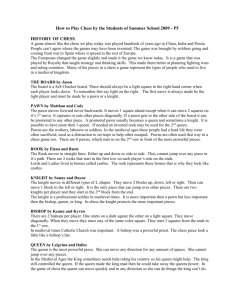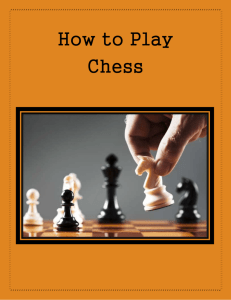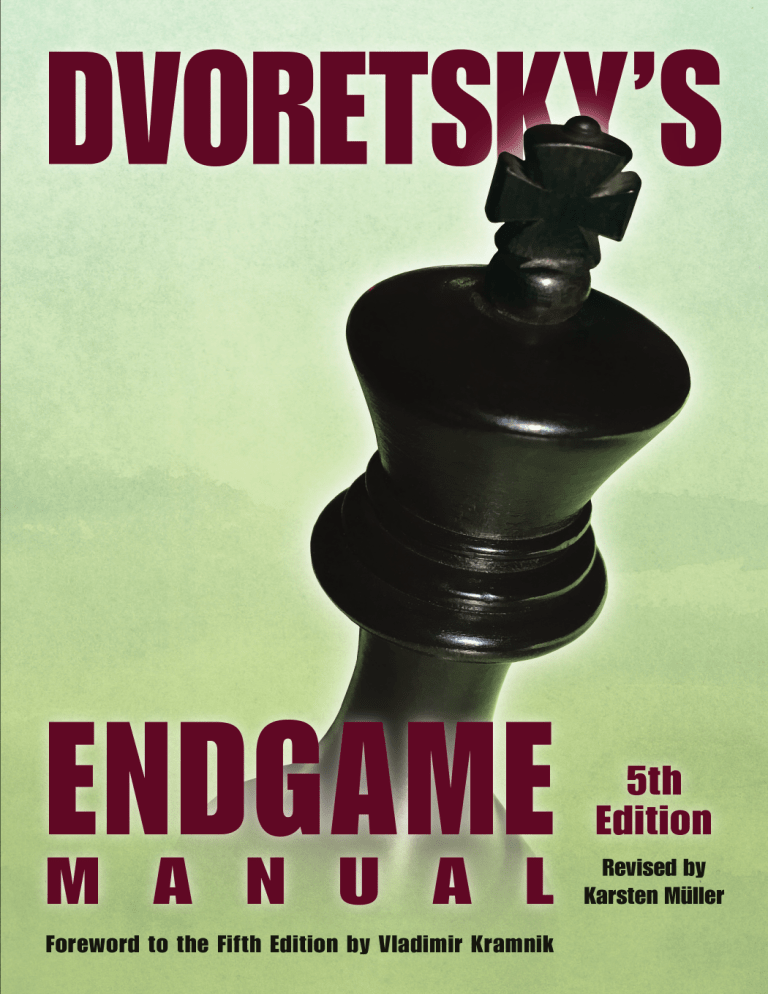
Dvoretsky’s
Endgame Manual
by
Mark Dvoretsky
Fifth Edition
Revised by Karsten Müller
Foreword by Vladimir Kramnik
2020
Russell Enterprises, Inc.
Milford, CT USA
1
Dvoretsky’s Endgame Manual
Dvoretsky’s Endgame Manual
© Copyright 2003, 2006, 2008, 2011, 2014
Mark Dvoretsky
© Copyright 2020
Leonid Dvoretsky
All Rights Reserved
ISBN: 978-1-949859-18-8 (print)
ISBN: 978-1-949859-19-5 (eBook)
No part of this book maybe used, reproduced, stored in a retrieval
system or transmitted in any manner or form whatsoever or by any means,
electronic, electrostatic, magnetic tape, photocopying, recording or otherwise,
without the express written permission from the publisher except in the case
of brief quotations embodied in critical articles or reviews.
Published by:
Russell Enterprises, Inc.
PO Box 3131
Milford, CT 06460 USA
www.russell-enterprises.com
info@russell-enterprises.com
Cover design by Opus 1 Design and Fierce Ponies
Printed in the United States of America
2
Table of Contents
From the Author, First Edition
Introduction to the Fifth Edition
Foreword by Vladimir Kramnik
Other Signs, Symbols, and Abbreviations
8
11
12
13
Chapter 1 Pawn Endgames
Key Squares
Corresponding Squares
Opposition
Mined Squares
Triangulation
Other Cases of Correspondence
King vs. Passed Pawns
The Rule of the Square
Réti’s Idea
The Floating Square
Three Connected Pawns
Queen vs. Pawns
Knight or Center Pawn
Rook or Bishop Pawn
Pawn Races
The Active King
Zugzwang
Widening the Beachhead
The King Routes
Zigzag
The Pendulum
Shouldering
Breakthrough
The Outside Passed Pawn
Two Rook Pawns with an Extra Pawn on the Opposite Wing
The Protected Passed Pawn
Two Pawns to One
Multi-Pawn Endgames
Undermining
Two Connected Passed Pawns
Stalemate
The Stalemate Refuge
“Semi-Stalemate”
Reserve Tempi
Exploiting Reserve Tempi
Steinitz’s Rule
The g- and h-Pawns vs. the h-Pawn
The f- and h-Pawns vs. the h-Pawn
Both Sides have Reserve Tempi
14
15
15
19
21
23
25
25
26
28
30
31
31
31
33
36
37
37
39
39
40
41
42
46
48
53
53
54
56
57
59
59
60
62
62
64
65
66
69
3
Dvoretsky’s Endgame Manual
Chapter 2 Knight versus Pawns
King in the Corner
Mate
Drawn Positions
Knight vs. Rook Pawn
The Knight Defends the Pawn
72
72
72
74
76
Chapter 3 Knight Endgames
The Deflecting Knight Sacrifice
Botvinnik’s Formula
Pawns on the Same Side
80
81
85
Chapter 4 Bishop versus Pawns
The Elementary Fortresses
Bishop and Rook Pawn
Pawns at h6 and h7
Pawns at g6 and g7
Bishop at h7 and Pawn at g6
Bishop vs. Disconnected Pawns
Bishop vs. Connected Pawns
92
92
96
97
97
99
100
Chapter 5 Opposite-Color Bishops
The Most Important Rules
Bishop and Two Connected Pawns vs. Bishop
Separated Passed Pawns
The King Blockades the Passed Pawn
The Bishop Restrains the Passed Pawn
103
104
107
111
115
Chapter 6 Bishops of the Same Color
Minimal Material
Bishop and Pawn vs. Bishop
Transposition to Positions with One Pawn
Interference
The Bad Bishop
Fixing Pawns
Zugzwang
Pawns Which Do Not “Play by the Rules”
Barrier
119
119
120
122
123
123
124
125
130
Chapter 7 Bishop versus Knight
Bishop and Pawn vs. Knight
Knight and Pawn vs. Bishop
The Bishop is Superior to the Knight
Cutting the Knight Off
Fixing the Pawns
The Passed Pawn
An Open Position, A More Active King
Defensive Methods with a Knight against a Bishop
The Knight is Superior to the Bishop
Domination and Knight Forks
Fixing the Pawns
Closed Position, Bad Bishop
132
134
136
136
137
138
140
143
145
145
146
147
4
Chapter 8 Rook versus Pawns
Rook vs. One Pawn
“Moving Downstairs”
Cutting the King Off
Pawn Promotion to a Knight
Stalemate
An Intermediate Check for a Gain of Tempo
Shouldering
Outflanking
Rook vs. Connected Pawns
Rook vs. Separated Pawns
Chapter 9 Rook Endgames
Rook and Pawn vs. Rook
The Pawn on the Seventh Rank
The Pawn on the Sixth Rank
The Pawn on the Fifth Rank
The Umbrella
The Pawn Has Not Crossed the Mid-line
A Rook and Rook Pawn vs. a Rook
The King is in Front of Its Own Pawn
The Rook is in Front of the Pawn and the
Pawn Is on the Seventh Rank
The Rook is in Front of the Pawn and the
Pawn Is on the Sixth Rank
a- and h-Pawns
A Rook and Two Pawns vs. a Rook
Doubled Pawns
Connected Pawns
f- and h-Pawns
Other Pairs of Disconnected Pawns
A Far Advanced Passed Pawn
Transition to a Rook vs. Pawns Endgame
Lasker’s Idea
A Rook and Two Pawns vs. a Rook and Pawn
All Pawns are on the Same Wing
Pawns on Opposite Wings
Disconnected Pawns, One of them is Passed
Four Pawns vs. Three on the Same Wing
Balance on One Wing and an Extra Pawn on Another
The Rook Behind Its Own Pawn
The Rook in Front of the Pawn, with the
Pawn on the Seventh Rank
The Rook in Front of the Pawn, with the Pawn on the Sixth Rank
A Knight Pawn
When the Attacker Achieves g3-g4
The Rook at the Side of the Pawn
Common Observations about Endgames with Many Pawns
The Rook’s Activity
The King’s Activity
The King on the Edge
Cutting the King Off
Akiba Rubinstein’s Masterpiece
5
151
151
151
151
152
152
153
153
155
158
160
160
161
165
167
168
171
171
172
173
175
176
176
177
179
182
184
184
186
187
187
191
195
199
205
205
208
215
229
235
238
242
242
246
248
250
251
Dvoretsky’s Endgame Manual
Chapter 10 Rook versus Knight
The Lone Knight
Rook and Pawn vs. Knight and Pawn
Multi-Pawn Endgames
Pawns on One Side of the Board
Pawns on Both Sides
When the Knight is Stronger than the Rook
255
256
261
261
264
265
Chapter 11 Rook versus Bishop
The Lone Bishop
The Dangerous Corner
The Safe Corner
A Bishop Pawn
Rook and Pawn vs. Bishop and Pawn
The Pawns are on the Same File or on Adjacent Files
Rook Pawns
Two Pawns vs. Two on the Same Wing
Three Pawns vs. Three on the Same Wing
267
267
268
270
271
271
275
278
282
Chapter 12 Queen Endgames
Queen and Pawn vs. Queen
Winning Tactical Tricks
Defensive Tactics
Pawns on the Same Wing
A Passed Pawn
An Active Queen
284
287
288
290
292
295
Chapter 13 Queen versus Rook
A Solitary Rook
Queen vs. Rook and Pawn
The Rook behind the Pawn
The Pawn on the Seventh Rank
The Pawn on the Sixth Rank
A Knight Pawn on the Fifth or Sixth Rank
Queen and Pawn vs. Rook and Pawn
Passed Pawns
Pawns on Adjacent Files
A Fortress with Multiple Pawns
297
299
299
300
301
304
305
305
307
308
Chapter 14 Other Material Relations
Two Extra Pieces
Checkmating with Bishop and Knight
Checkmating with Two Knights
Rook and Knight vs. Rook
Rook and Bishop vs. Rook
Without Pawns
With Pawns
An Extra Bishop or Knight with Queens or Minor Pieces
Rook vs. Two Minor Pieces
Queen vs. Various Pieces
Queen vs. Two Rooks
313
313
314
314
316
316
319
320
321
325
328
6
Chapter 15 General Endgame Ideas
King’s Activity
Pawn Power
Zugzwang
Fortresses
A Fortified Camp
A Pawn Barrier
An Imprisoned King
An Imprisoned Piece
Binding
Stalemate
Checkmate
Domination
331
337
342
345
345
346
348
350
351
352
356
359
Chapter 16 Solutions
362
Bibliography
422
Indexes
Index of Players
Index of Composers and Analysts
Index of Strategic and Tactical Techniques
425
434
437
7
Dvoretsky’s Endgame Manual
Foreword
There are many chess endgame books, and some of them are very instructive and undoubtedly are
worth careful study. But in my view, Dvoretsky’s Endgame Manual can be called the Bible among them
because the material in it is very well structured and explained.
There are many existing theoretical endgames and it is impossible to remember them all. It is therefore
necessary to select those which have a “basic structural value.” I think Dvoretsky succeeded in doing this
very well, making outstanding and painstaking efforts to select the “endgame knowledge base” for a chess
player. The book contains all that you NEED to know and sets aside everything superfluous, or more
precisely, what is not so necessary to remember.
Although of course I had fully mastered this material when the book first came out, I always had it
close at hand. Before my world championship matches and candidates’ tournaments, I always refreshed and
reinforced these endings in my memory by glancing through this book.
Indeed, modern chess has changed a lot, and very often you have to make critical decisions with little
time on the clock. A player is often faced with calculating in the seventh hour of play, trying to find the best
move, for which there is often simply neither time nor energy. To handle a situation like that, it is crucial
to have markers – beacons in this vast ocean of possibilities in the endgame – to know well which endings
are winning and which are not, and to have at least a rough idea of how to play them.
While it is impossible to remember everything, if a chessplayer has at his command the assessment
and the core criteria of play in theoretical endings, the benefits will be obvious.
Of course, it does not often happen that a precise position from the book appears on the board. But
your endgame technique is certain to improve, as well as your defensive abilities. The fact is, if you know
which theoretical endings you should enter and which you should not, depending on the result you
are trying to achieve, this is a tremendous help in making the correct decisions in many other endgames not
covered here.
I think that all chessplayers should express their gratitude to Mark Dvoretsky for undertaking such
work, synthesizing in a practical format and in a condensed and well-explained form, the most important
endgame knowledge which every chessplayer must possess.
Naturally, in today’s world, everyone has gotten used to working with computers, and you can pull up
a tablebase and see how a theoretical endgame is evaluated, what correct moves should be made.
But it is impossible to attain real endgame mastery by just working with a computer. An explanation of
why an endgame is winning, and how to win (or save) it from a human point of view, described in words
and in language that a person understands (as opposed to computer variations), is needed.
In short, I consider Dvoretsky’s Endgame Manual an absolute must for every chess professional, and
no less important even for a club player. Learn the endgame principles in this book well, refresh them in
your memory from time to time, and your rating and your tournament performances will surely improve.
I often get questions from both chess amateurs and professionals about which books to study to
improve their play. The list is short, but have no doubt – I always recommend this book for everyone.
I consider it to be one of the very best chess books published in recent times and I am very pleased with
the new enhanced edition that has come out.
Vladimir Kramnik
14th World Champion
April 2020
12
Chapter 6
Bishops of the Same Color
cuuuuuuuuC
{wDBdwDwD}
6-2{IwDwDwDw}
{w)wdwDwD}
{iwDwDwDw}
{wDwDbDwD}
W{DwDwDwDw}
{wDwDwDwD}
{DwDwDwDw}
vllllllllV
Minimal Material
Bishop and Pawn vs. Bishop
These endgames were first subjected to
thorough analysis in the mid-19th century by the
Italian player Centurini. Later, significant additions
to the theory were made by GM Averbakh.
cuuuuuuuuC
{wDwdwDwD}
6-1{DwIwDwDw}
{wdw)wDwD}
{DBDwiwDw}
{wDwDwDbD}
{DwDwDwDw}
{wDwDwDwD}
{DwDwDwDw}
vllllllllV
1 Bb7 Bf5 2 Bf3 Bc8 3 Be2*i
All the squares on the c8-a6 diagonal, except
c8, are under the control of White pieces – that is
why we get zugzwang. Now, if we were to move the
entire position down one rank, the bishop would get
another free square, and White could no longer win.
The following position of reciprocal zugzwang
has some practical significance.
White to move wins, by driving off the enemy
bishop from one diagonal, and then interfering
along the other diagonal.
1 Bd7 Bd1 2 Bh3 Ba4 3 Bg2 $ 4
Bc6i
Can this plan be prevented? Yes, it can – provided Black’s king can get to c5, preventing
White’s bishop from interfering along the diagonal.
Black to move draws:
1...Kd4! (but not 1...Kd5? 2 Bd7 Bd1 3 Bc6+
and 4 d7) 2 Bd7 Bd1 3 Bh3 Ba4 4 Bg2
Kc5!= Thus, if the weaker side’s king cannot get in
front of the pawn, then the basic defensive principle
becomes: king behind the king!
The short diagonal: even with the “right” king
position, the draw is impossible if one of the diagonals along which the bishop will restrain the pawn
proves too short.
cuuuuuuuuC
{wDwiwDwD}
6-3{DbDwDwDw}
{w)wIBDwD}
$
{DwDwDwDw}
{wDwDwDwD}
{DwDwDwDw}
{wDwDwDwD}
{DwDwDwDw}
vllllllllV
White to move only draws. 1 Bd5 Kc8 (or
1...Ba6) is useless. On 1 Bf5, there follows
1...Bf3 2 Be6 $ 3 Bd5i) 2...Bb7! 3 Kc5
Bf3 (3...Ke7? 4 Bd5) 4 Bd5 Be2 ($ Kc8) 5
Bb7 Kd7=
But what is Black to do if it is his move? Any
bishop retreat along the h1-a8 diagonal is refuted by
2 Bd5; therefore, he must play 1...Ba6. By the way
119
Dvoretsky’s Endgame Manual
(here’s a tragicomedy!), in this won position,
Botvinnik accepted a draw against Model in the 1931
Leningrad Championship.
The path to victory is not complicated: 2 Kc6!
Bc8 3 Bc4!* Bg4 4 Kb7! Bf3+ 5 Ka7 $
Ba6-b7i
Capablanca – Janowsky
New York 1916
cuuuuuuuuC
{wDwDwDkD}
6-5{DwDwDwDw}
{wDwDwDPD}
{DpDKDwDw}
{wDwGwDwD}
W{DPDwDwDw}
{wDwgwDwD}
{DwDwDwDw}
vllllllllV
Transpositions to Positions
with One Pawn
Charushin – Rosenholz
cr 1986
cuuuuuuuuC
{wDBDwDwD}
6-4{DwDwDwDw}
{PiwDwDwD}
{DwDwDwIw}
{wDwDwDpD}
W?{DwDwDw)w}
{wDwDbDwD}
{DwDwDwDw}
vllllllllV
A typical situation: White can take the g4-pawn
only at the cost of his a6-pawn. The question is
whether the enemy king can get back in time.
1 Kf4!*
Excellently played! White improves his own
king’s position (now it no longer stands in the path
of its pawn) while simultaneously using zugzwang
to force the enemy king further away from the
kingside. The hasty 1 Bxg4? Bxa6 2 Kf4 Kc7 3 Bf3
Kd6 4 g4 Ke7 leads only to a draw.
1...Ka7~ (1...Kc7 2 a7 Bf3 3 Bxg4) 2 Bxg4
Bxa6 3 Bf3 Kb6
No better is 3...Bc8 4 Be4 Kb6 5 Bf5.
4 g4 Kc5 5 g5 Kd6 6 g6 Ke6
Nothing is changed by 6...Ke7 7 Kg5 Kf8 8
Kh6 Bc4 9 g7+ Kg8 10 Be4 $ 11 Bh7+.
7 Kg5 Bc4 8 g7
Black resigned, in view of 8...Kf7 9 Kh6 Kf6
10 Kh7 Kg5 11 Kh8 Kh6 12 Be4, followed by
Bh7-g8 (the h7-g8 diagonal, where the black bishop must move, is too short).
White has nothing to play for, other than to pick
up the b-pawn in exchange for his g6-pawn.
Unfortunately, this plan would not be enough to win.
I present the main variation: 1 Kc5 b4 2 Kc4 Be1
3 Bc5 Kg7 4 Bxb4 Bg3! (Averbakh’s analysis
shows that 4...Bf2 also draws, but that 4...Bh4?
loses) 5 Bc3+ Kxg6 6 b4 Kf7 7 b5 Bc7! 8 Kd5 Ke7
9 Kc6 Kd8 10 Kb7 Kd7=
1 Ke4
Capablanca is in no hurry to force matters – he
maneuvers, hoping for a mistake by his opponent.
1...b4
By no means forced (1...Be1 2 Kd3 Bb4 3 Bc3
Be7 is not bad); but, on the other hand, it does not
spoil anything.
2 Be3 Bc3 3 Kd3 Be1 4 Bd2 Bf2 5
Ke4 (5 Bxb4 Kg7=) 5...Bc5?
And here is the mistake! Now White captures
the b4-pawn, with a tempo ahead of the other
variations. First Black had to lure the king away from
the queenside: 5...Kg7! 6 Kf5, and now he can
defend the pawn (6...Bc5 7 Bf4 Bf2 8 Be5+ Kg8=).
6 Kd5! Be7
Still worse is 6...Bf2 7 Bxb4 Kg7 8 Bc3+ Kxg6
9 b4 Kf7 10 Bd4 Bg3 11 b5 Bc7 12 Kc6 Ba5 13
Be5 $ Bc7i
7 Kc4 Kg7 8 Bxb4 Bd8 9 Bc3+?
White errs in return – although it is not at all
obvious. The win was 9 Bd2! – a variation we shall
examine later.
9...Kxg6 10 b4 Kf5 11 Kd5
120
Bishops of the Same Color
cuuuuuuuuC
{wDwgwDwD}
6-6 {DwDwDwDw}
{wDwDwDwD}
{DwDKDkDw}
{w)wDwDwD}
B? {DwGwDwDw}
Play {wDwDwDwD}
{DwDwDwDw}
vllllllllV
In this position, Janowsky resigned. And
wrongly so – as Averbakh has shown. Black could
get a draw by employing the basic defensive plan of
“king behind king.”
Since White is going to put his king on c6,
Black must hurry his king over to c4:
11...Kf4!! 12 Bd4 (12 Be5+ Ke3 13 b5 Kd3
14 Kc6 Kc4=) 12...Kf3! 13 b5 (13 Bc5 Ke2 14
Kc6 Kd3 15 Kd7 Bg5 16 b5 Kc4) 13...Ke2! 14
Kc6 Kd3 15 Bb6 Bg5 16 Bc7 Be3
After 17 Bd6 Kc4, Black prevents the interference along the diagonal at c5 just in time. But the
struggle is not over yet.
17 Kd5!
cuuuuuuuuC
{wDwDwDwD}
6-7{DwGwDwDw}
{wDwDwDwD}
{DPDKDwDw}
{wDwDwDwD}
B?{DwDkgwDw}
{wDwDwDwD}
{DwDwDwDw}
vllllllllV
The most dangerous continuation, as pointed
out by Issler. If Black now plays 17...Kc3? then 18
Bd6 Bb6 (18...Kb3 19 Bc5 Ka4 20 Kc6) 19 Kc6.
Black has no time to play Kc4 – White is ready to
reply with either 20 Bc7 or Bc5, depending on
where Black’s bishop retreats.
Black is saved by a tactic, which is very useful
to remember: it is a typical trick in bishop endgames.
17...Bd2!!
On 18 b6, the pin 18...Ba5 saves him.
18 Bd8 Be3!
Now the threat of 19 b6 Ba5 20 b7 forces
Black to retreat. That is fine – White’s bishop stands
worse on d8 than it did on c7, and there is no longer
any danger in 19 Be7 ($ 20 Bc5) 19...Bb6! 20
Kc6 Ba5! (White no longer has 21 Bc7) 21 Bd6
Kc4=
White has just one final trap:
19 Bc7 Bd2! 20 Kc6 Be3! 21 Kb7! (21
Bd6 Kc4=) 21...Kc4 22 Ka6 Kb3!!
Once again, the same technique of “king behind
king”: the black king heads for a4. He would lose
after 22...Bf2? 23 Bb6 Bh4 24 Be3 Bd8 25 Bd2
$ Ba5i And 22...Kb4? 23 Bb6 Bg5 24 Ba5+
and 25 b6i is wrong too.
23 Bb6 Bg5 24 Bf2 Bd8 25 Be1 Ka4=
All that is left for us to see is what would have
happened, had Capablanca played more precisely
on his ninth move.
cuuuuuuuuC
{wDwgwDwD}
6-8{DwdwDwiw}
{wDwDwDPD}
{DwDwDwDw}
{wGKDwDwD}
W?{DPDwdwDw}
{wDwDwDwD}
{DwDwDwDw}
vllllllllV
9 Bd2! Kxg6 10 b4 Kf5 11 Kd5
Now we are looking at the position from the
next-to-last diagram, but with the bishop on d2 (instead of c3). Here Black’s king is unable to get behind White’s.
11...Kg4 12 b5 Kf3 13 Kc6 Ke4 14 Kb7!!
Kd3 15 Be1! Kc4 16 Ka6 Kb3 17 Ba5 Bg5 18
b6i
121
Dvoretsky’s Endgame Manual
Interference
We know that interference is the primary instrument by which the stronger side secures (or
attempts to secure) the queening of its pawn. In all
the examples we have looked at thus far, the bishop
has done this work. But sometimes (although certainly not nearly as often), interference is carried out
with the aid of the pawns. For instance, there is the
following spectacular study.
P. Heuäcker 1930
cuuuuuuuuC
{wGwDwDwD}
6-9{DwDwDwDw}
{wDwDwDw)}
{DwDw0wDw}
{wDwgwDwi}
W?{DwDwDwDw}
{wDwDwDwD}
{DwIwDwDw}
vllllllllV
1...Be5?? 2 Bxe5 Kd5 3 Bg7?? Kc4!, and
Black won.
The same tactical idea of interference as in the
Heuäcker study brought Black success here.
However, this occurred only as a result of his
opponent’s gross blunder. After 3 Kd3! Kxe5
(3...a2? 4 Bg7i) 4 Kc2, the king is in the square
of the a-pawn.
Black should have carried out his interference
in a more primitive form, by preparing ...Be5. This
could have been achieved either by 1...Kd5 2 Kd3!?
Ke6! (but not 2...a2? 3 c4+) 3 Bd4 a2 4 c4 Be5, or
by 1...Kd6 2 c4 Be5 (2...a2; 2...Ke6) 3 c5+ Ke6!o
(3...Kd5? is a mistake, because of 4 c6=).
Exercises
1 Ba7! (1 h7? e4=) 1...Ba1 2 Kb1 Bc3 3
Kc2 Ba1 4 Bd4!! Bxd4 (4...ed 5 Kd3i) 5
Kd3 Bb2 6 Ke4i
Tragicomedies
We have already seen the tragicomedies that
occurred in the games Botvinnik-Model and
Capablanca-Janowsky. I will add one more example.
Savchenko – Krivonosov
USSR 1989
cuuuuuuuuC
{wDwDwDwD}
6-10
{DwDwDwDw}
{wDkDwGwD}
{DwDwDwDw}
{wDwDwDwD}
B{0w)wDwDw}
{wDwDKDwg}
{DwDwDwDw}
vllllllllV
122
cuuuuuuuuC
{wDKGwDwD}
6-11
{DPDwDwDw}
{wDkDwDwD}
{DwDwDwDw}
6/1{wDwDwDwD}
W?{DwDwDwDw}
{wDwDwDwg}
{DwDwDwDw}
vllllllllV
cuuuuuuuuC
{wDwDwDwD}
6-12
{DBDwDwDw}
{wDwDwDwD}
{IwDwDwiw}
6/2{w)wDwDwD}
B?{DwDwDwDw}
{wDwDwDwD}
{DwDbDwDw}
vllllllllV
cuuuuuuuuC
{wibDBDwD}
6-13
{DwDwIwDw}
{wDP0wDwD}
{DpDwDwDw}
6/3{wDwDwDwD}
W?{DwDwDwDw}
Play
{wDwDwDwD}
{DwDwDwDw}
vllllllllV
Bishops of the Same Color
cuuuuuuuuC
{wDwDwDwD}
6-14
{DwDwDKDp}
{wDkDPDwD}
{DwDwDwDw}
6/4{wgwDwDwD}
W?{DwDwDwGw}
{wDwDwDwD}
{DwDwDwDw}
vllllllllV
cuuuuuuuuC
{wDwDwDwD}
6-15
{DBDwDwDw}
{wDPDbDwD}
{DwDwDwDk}
6/5{wDwDwDwD}
W?{Dw0wDPDw}
Play
{w0PDwDPD}
{DKDwDwDw}
vllllllllV
Fixing Pawns
Averbakh – Veresov
Moscow 1947
cuuuuuuuuC
{wDwDwDwD}
6-16
{0wDwDwDw}
{w0bDwDpD}
{DwDwiwDp}
{wDPDpDwD}
W{)PDwIw)w}
{wDwDBDw)}
{DwDwDwDw}
vllllllllV
The Bad Bishop
A vital principle of chess strategy (which is
certainly applicable to more than just the endgame)
requires us not to place our pawns on the same
color squares as our own bishop.
In the first place, pawns that are fixed on the
same color squares as the bishop limit its mobility –
this is why such a bishop is called “bad.”
In the second place, a bad bishop is unable to
attack the enemy pawns (which are usually placed
on the opposite color squares), which dooms it to
passive defense of its own pawns.
And third, since both pawns and bishop control
only one color of squares, there will be “holes” in
between those squares that the enemy pieces will
occupy.
1 h4!
The experienced player makes such moves –
fixing the enemy pawns on the same color squares
as his bishop – without thinking.
White has a great positional advantage. After
the necessary preparations, he will create an outside
passed pawn on the queenside, which will divert the
enemy forces, allowing White to fall upon the kingside pawns.
1...Bd7 2 Bf1 a5 3 Bg2 Bc6 (3...Bf5 4
Bh1*) 4 Bh3!
The bishop aims for d7, where it will support
the queenside pawn advance while at the same time
be ready to attack the pawn at g6. For example:
4...Ba8 5 Bd7 Bb7 6 b4 ab 7 ab Ba8 8 c5 bc 9 bc
Kd5 10 Be8
cuuuuuuuuC
{bDwDBDwD}
6-17
{dwDwDwDw}
{wdwDwDpD}
{Dw)kdwDp}
{wDwDpDw)}
B {dwDwIw)w}
{wDwDwDwd}
{DwDwDwDw}
vllllllllV
10...g5! (10...Kxc5 11 Bxg6 Kd6 12 Bxh5 Ke5
13 Bg6 Bc6 14 g4i) 11 hg Kxc5 12 Bg6! Bd5
13 Bxe4 Bg8 14 Kf4 Kd6 15 Kf5 Ke7 16 Kg6i
4...b5 6 cb Bxb5 6 Bc8 Bc6 7 b4 ab 8 ab
Bb5 9 Bb7 g5!
123
Dvoretsky’s Endgame Manual
On 9...Bd3, 10 Bc6 Kf5 11 b5 (11 Bd7+)
11...Kg4 (11...Bxb5 12 Bxb5 Kg4 13 Kf2 e3+ 14
Kg2i) 12 b6 Ba6 13 Kf2 e3+ 14 Kg2 is decisive.
10 Bxe4 gh 11 gh Ba4
11...Be8 loses also: 12 Bf3 Kf5 13 Be2! (but
not 13 Kd4? Kf4 and 14...Kg3) 13...Ke5 14 Bd3!*
Bd7 (14...Kd5 15 Kf4 Kd4 16 Be2i) 15 Bg6
Kd5 16 Bxh5 Kc4 17 Be2+ Kxb4 18 h5 Bf5 19
Bd3 Be6 20 h6 Bg8 21 Kd4i
12 Bg6 Bd1 13 b5 Kd5 14 Kf4 Kc5 15
Kg5 Be2! (15...Kxb5 16 Bxh5 Bc2 17 Be8+ Kc5
18 h5 Kd6 19 Kf6!i)
cuuuuuuuuC
{wDwDwDwD}
6-18
{dwDwDwDw}
{wdwDwDBD}
{DPiwdwIp}
{wDwDwDw)}
W?{dwDwdwdw}
{wDwDbDwd}
{DwDwDwDw}
vllllllllV
16 Be8!*
We know this technique from the ending
Charushin-Rosenholz (diagram 6-4). Before taking
the pawn, it is important to drive the black king back
to b6 – as far as possible from the kingside. The hasty
16 Bxh5? Bxb5 17 Bg4 Be8 18 Bf5 Kd6 19 Bg6
Ke7! leads only to a draw.
16...Kb6 17 Bxh5 Bxb5 18 Bg4 Be8 19
Bf5 Kc7 20 Bg6 Kd8 21 Kf6! Black resigned
(analysis by Averbakh).
Y.Averbakh 1954
cuuuuuuuuC
{wDwDwDwD}
6-19
{DwDwDbDw}
{pDwiwDwD}
{DpDpDpDp}
{w)wIw)w)}
W{Dw)w)BDw}
{wDwDwDwD}
{DwDwDwDw}
vllllllllV
The correspondence between the f3- and f7squares is obvious – to win, it is necessary only to
give Black the move. If you like, you can also find
other pairs of corresponding squares (for example,
the f1- and b3-squares also correspond to f7), but
there is no real need.
1 Be2 Be8
If 1...Bg6, then 2 Bd3 Bh7 3 Bf1! Bg6
(3...Bg8 4 Be2 Bf7 5 Bf3*) 4 Bg2 Bf7 5 Bf3*
2 Bd3 Bg6
2...Bd7 3 Bc2 Be6 4 Bd1 Bf7 5 Bf3*
3 Bc2 Bh7 4 Bb3! Bg8 5 Bd1 Bf7 5
Bf3i
Now, let’s look at a considerably more complex
endgame.
Shabalov – Varavin
Moscow 1986
cuuuuuuuuC
{wDwgwDwD}
6-20
{DwDwDwDw}
{wDkDwDpD}
{0wDw0wDw}
{wDKDPDPD}
W{DPDwDwDw}
{wDwGwDwD}
{DwDwDwDw}
vllllllllV
Zugzwang
With a bad bishop, the weaker side’s defensive
hopes often are destroyed through zugzwang. Here
is the simplest example:
1 Be1 Bb6
On 1...Bc7? 2 Bc3, Black is in zugzwang, and
must put another pawn on the same color as his
bishop, making his opponent’s winning task that
much simpler. For example, 2...g5 3 Bb2 Bd6 4
124
Bishops of the Same Color
Bc1 Be7 5 Be3 Bf6 (5...Bd8 6 Bd2*) 6 Bc5 Bd8
7 Ba3 Bb6 (7...Bf6 8 Bb2 $ Bc3) 8 Bb2 Bc7 9
Bc3* White’s bishop maneuvers here in roughly
the same way as it did in the preceding example.
2 Bh4! Be3
The c7-square turns out to correspond, not just
to the c3-square, but also to g3. 2...Bc7? would be
bad: 3 Bg3! Bb8 4 Be1 Bc7 5 Bc3. And on
2...Bd4? 3 Bd8 decides.
3 Bg3 Bd4
After 3...Bf4? 4 Be1, Black must defend the
a5-pawn with his king, and allow the enemy king to
enter. This does not bode well for Black: 4...Kb6 5
Kd5 Kb5 6 Bc3 g5 7 Bxe5 Bxe5 8 Kxe5 Kb4 9
Kd5 Kxb3 10 e5 a4 11 e6 a3 12 e7 a2 13 e8Q a1Q
14 Qe3+ Kc2 15 Qe2+ forcing the exchange of
queens.
4 Bh2!* Bb2
4...Ba1? loses to 5 Bg1 Bb2 6 Bf2 $ Be1i
5 Bg1 Ba3!
On 5...Bc1?, White wins with 6 Bc5 Bd2 7 Ba3
Bg5 8 Bb2i
6 Bf2 Be7!
Otherwise, we get the basic zugzwang position:
6...Bd6? 7 Be1 Bc7 8 Bc3* or 6...Bb4? 7 Bg3
Bd6 8 Be1, etc.
7 Bg3! Bf6
By means of a series of accurate maneuvers,
Shabalov has achieved his aim – the bishop has been
deflected onto a poor diagonal. On the other hand,
there was no longer any choice: 7...Bd6? 8 Be1 Bc7
9 Bc3*i
cuuuuuuuuC
{wDwdwDwD}
6-21
{DwDwDwDw}
{wDkDwgpD}
{0wDw0wDw}
{wDKDPDPD}
W?{DPDwDwGw}
{wDwdwDwD}
{DwDwDwDw}
vllllllllV
10 Bxe5 Be7 11 Bf6 Bb4?
The decisive error. After the accurate 11...Bc5
12 Bc3 (12 Bd8 Bb4 13 Kd4 Kd6) 12...Bb6
(shown by Aczel) realizing the extra pawn is
evidently not possible.
12 Bc3!
Advancing the e-pawn does nothing for White:
12 e5 Bd2 13 e6 Kd6 14 e7 Kd7. So he takes the
a5-pawn in exchange for the g5-pawn.
12...Be7 13 Bxa5 Bxg5 14 b4 Bf4 15
b5+ Kd6 16 Bc3! g5 17 e5+ Kc7
17...Bxe5 18 Bxe5+ Kxe5 19 b6! (but not 19
Kc5? Ke6) 19...Kd6 20 Kb5 g4 21 Ka6i
18 Ba5+ Kc8 19 Kd5 g4 20 e6 g3 21 Kc6!
Bg5 (22 e7 was threatened) 22 b6 Black resigned.
Pawns Which Do Not
“Play by the Rules”
In chess, there are no absolute laws. Even so
important and generally useful an axiom as the
unprofitability of placing one’s pawns on the same
color squares as one’s bishop must occasionally be
broken. Here are the possible reasons for doing so:
- To restrict the mobility of the enemy bishop
using one’s own pawns (as occurred in the preceding example);
- The need to undermine the enemy pawn
chain; and
- The attempt to create an impregnable fortress
around a “bad bishop.”
The first and third points are illustrated by the
following case:
Wojtkiewicz – Khalifman
Rakvere 1993
8 Bh2* Bg7 9 g5!
White “breaks the rule,” by moving a pawn onto
a square the same color as his own bishop – in order
to restrict the enemy bishop’s mobility still further.
There is no other way to make any progress.
9...Bf8
9...Bh8? 10 Bg3 Bg7 11 Be1 is hopeless.
125
cuuuuuuuuC
{wDwDwDwD}
6-22
{DpDwDw0w}
{w0wib0w0}
{DwDpDwDw}
{wDwDw)PD}
W?{)wIw)wDP}
{w)wDwDBD}
{DwDwDwDw}
vllllllllV

